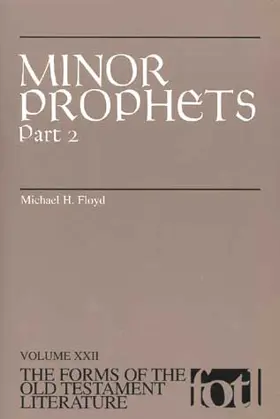

Minor Prophets, Part 2
in Forms of the Old Testament Literature
Pages
651 pages
Publisher
Eerdmans
Published
3/1/2000
ISBN-13
9780802844521
Minor Prophets, Part 2 is Volume XXII of The Forms of the Old Testament Literature, a series that aims to present a form-critical analysis of every book and each unit in the Hebrew Bible. Fundamentally exegetical, the FOTL volumes examine the structure, genre, setting, and intention of the biblical literature in question. They also study the history behind the form-critical discussion of the material, attempt to bring consistency to the terminology for the genres and formulas of the biblical literature, and expose the exegetical process so as to enable students and pastors to engage in their own analysis and interpretation of the Old Testament texts.
In this volume Floyd presents a complete form-critical analysis of the last six books in the Minor Prophets: Nahum, Habakkuk, Zephaniah, Haggai, Zechariah, and Malachi. By looking carefully at the literary genre and internal structure of each book, Floyd uncovers the literary convention that help shape the composition of these prophetic books in their final form. His approach yields fresh views of how the parts of each book fit together to make up the whole — particularly with respect to Nahum, Haggai, and Malachi — and provides a basis for reconsidering how each book is historically related to the time of the prophet for whom it is named. This work will be useful to scholars because it advances the discussion regarding the holistic reading of prophetic books, and useful to pastors and student because it shows how analysis of literary form can lead to a more profound understanding of the messages of the Minor Prophets.
Collections
This book appears in the following featured collections.
- Tremper Longman's 5-Star Commentaries by Tremper Longman III
- TGC: Scholarly Commentaries by The Gospel Coalition
Reviews
On the surface this volume follows the well-established pattern of the series. The biblicaltext is commented on unit by unit, with the headings: Text, Structure, Genre, Setting,Intention, and Bibliography. The typography and layout will be immediately familiar tousers of other volumes in this well-established series. Like those other volumes, Floyd’sincludes a useful “glossary” with concise definitions for key descriptors of genres andformulas. Again like other FOTL volumes, Floyd’s contribution provides the user with acomprehensive yet focused discussion, and like them it will prove a useful addition to thelibraries used by the wide target audience of “scholars, pastors and students” envisagedby the publishers.However, beneath this conformity of form there has been a revolution of approach. Theseries of which this work is part represents the final flowering of modern historicalcriticism in Old Testament studies. Yet the volume appears at a time when the underlying“certainties” of that approach are no longer dominant in the field.The modernist assumptions of the series are revealed by some of the phrases used by theeditors in their foreword to this volume.
[Full Review]

